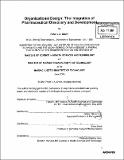| dc.contributor.advisor | Nelson Repenning and Brian Seed. | en_US |
| dc.contributor.author | Smith, Peter J. A. (Peter John Anthony), 1959- | en_US |
| dc.contributor.other | Harvard University--MIT Division of Health Sciences and Technology. | en_US |
| dc.date.accessioned | 2005-09-27T17:11:06Z | |
| dc.date.available | 2005-09-27T17:11:06Z | |
| dc.date.copyright | 2004 | en_US |
| dc.date.issued | 2004 | en_US |
| dc.identifier.uri | http://hdl.handle.net/1721.1/28588 | |
| dc.description | Thesis (S.M.)--Harvard-MIT Division of Health Sciences and Technology; and, (S.M.M.O.T.)--Massachusetts Institute of Technology, Sloan School of Management, Management of Technology Program, 2004. | en_US |
| dc.description | Includes bibliographical references (leaves 60-61). | en_US |
| dc.description.abstract | The decline in Pharmaceutical R&D productivity has been attributed to high clinical failure rates suggesting that targets, leads and clinical candidates may be of lower quality in recent years. Senior R&D management generally believes that a greater integration of drug discovery and development will improve the selection and optimization of clinical candidates. I demonstrate the different nature of discovery and development with discovery tasks seen as more uncertain, having more reciprocal work flows and more under the control of management than development tasks. Discovery and development personnel have different characteristics and motivations, with discovery staff having greater creative skills and development staff greater planning skill. Following a congruence approach to organization design these differences imply that a complete merging of discovery and development functions would lead to poor fit between organizational design elements. This leaves an ongoing requirement for integrative systems which can preserve the important characteristic of discovery and development functions yet provide knowledge integration at key decision points to improve the quality of clinical candidates. A wide range of integrating mechanisms was found to be in use with an emphasis on cross functional teams. Information Technology was viewed as necessary infrastructure but not an important component of knowledge integration. No strong links were found between pipeline maturity and the integrative mechanism deployed. I speculate that company R&D performance could be better matched to internal and external circumstances by a more active approach to managing integrative systems. I propose a conceptual model of integrative systems to guide a more dynamic management approach | en_US |
| dc.description.abstract | (cont.) to organizational design of R&D and suggest further work to formalize the model through an agent based simulation. | en_US |
| dc.description.statementofresponsibility | by Peter J.A. Smith. | en_US |
| dc.format.extent | 69 leaves | en_US |
| dc.format.extent | 2976003 bytes | |
| dc.format.extent | 2982790 bytes | |
| dc.format.mimetype | application/pdf | |
| dc.format.mimetype | application/pdf | |
| dc.language.iso | en_US | |
| dc.publisher | Massachusetts Institute of Technology | en_US |
| dc.rights | M.I.T. theses are protected by copyright. They may be viewed from this source for any purpose, but reproduction or distribution in any format is prohibited without written permission. See provided URL for inquiries about permission. | en_US |
| dc.rights.uri | http://dspace.mit.edu/handle/1721.1/7582 | |
| dc.subject | Management of Technology Program. | en_US |
| dc.subject | Harvard University--MIT Division of Health Sciences and Technology. | en_US |
| dc.title | Organizational design : the integration of pharmaceutical discovery and development | en_US |
| dc.type | Thesis | en_US |
| dc.description.degree | S.M.M.O.T. | en_US |
| dc.description.degree | S.M. | en_US |
| dc.contributor.department | Management of Technology Program. | en_US |
| dc.contributor.department | Harvard University--MIT Division of Health Sciences and Technology | |
| dc.contributor.department | Sloan School of Management | |
| dc.identifier.oclc | 57490175 | en_US |

